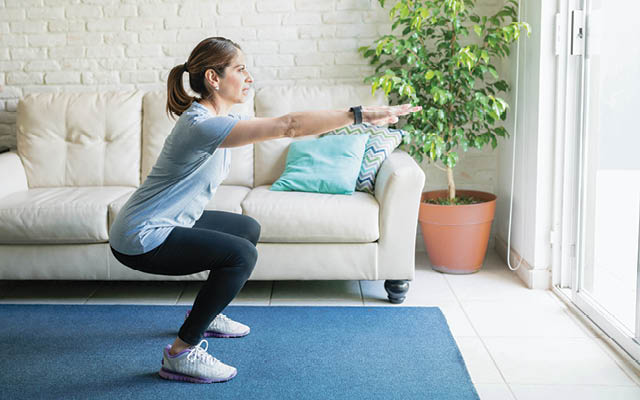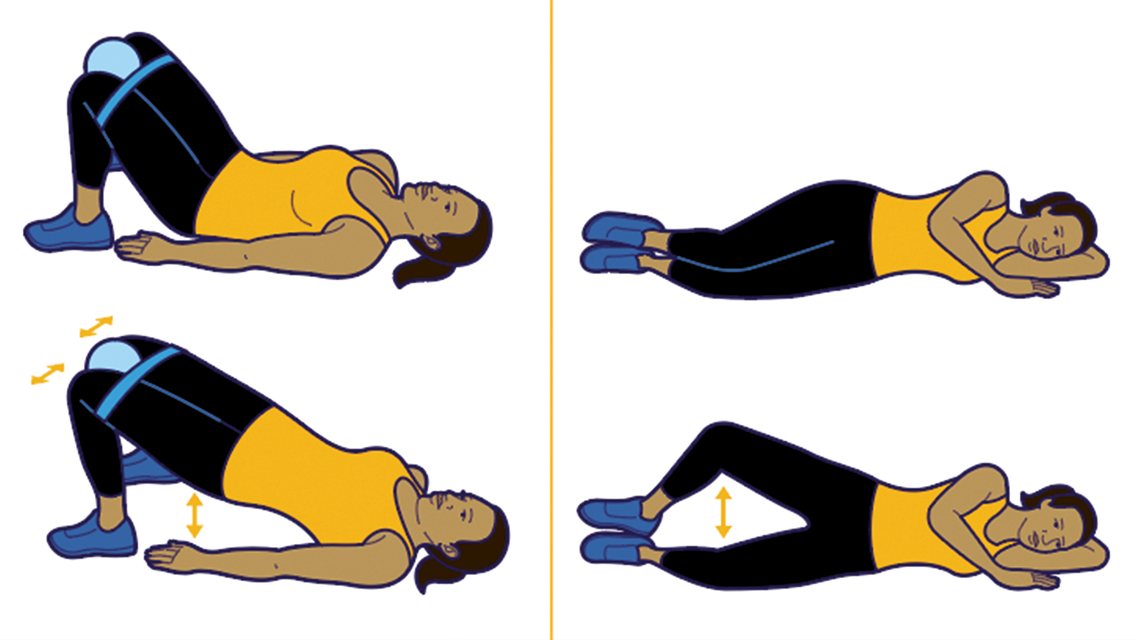There are myriad factors that can compromise the health of your pelvic floor, but there are just as many approaches you can take to lower the probability of experiencing issues. Use the following three strategies to keep these muscles healthy and functional for life.
1. Retrain your breathing.
A simple way to improve pelvic-floor mobility and function is to shift to diaphragmatic breathing. During a natural breath, “when you take a deep inhale, the respiratory diaphragm and pelvic-floor diaphragm both descend,” says Meagan Corrao, PT, DPT, a certified pelvic-rehabilitation practitioner and clinical specialist with Northwell Health Rehabilitation Network. On the exhale, they both rebound to their usual position.
To breathe diaphragmatically, focus on expanding your abdomen on the inhale, aiming to fill your ribcage and back. “Imagine if you were to blow air into a balloon, all parts of the balloon expand,” says Megan Rorabeck, DPT. “When you breathe into your belly, think of the belly and the pelvic floor expanding together, like the balloon.” (Get step-by-step instructions at “6 Exercises for a Healthy Pelvic Floor.”)
She recommends first practicing diaphragmatic breathing while lying in bed at night to get the hang of it. That way, you can more easily tap into this approach when you’re stressed and anxious or you notice you’re clenching your jaw. “To be effective at doing it in the heat of the moment when our body needs it most, we have to be able to fall back on some muscle memory.”
2. Exercise to strengthen and lengthen.
Performing exercises that stretch and strengthen your pelvic-floor muscles can help you prevent overactivity and underactivity.
Kegels are perhaps the best-known pelvic-floor exercises: You squeeze, hold, and relax your pelvic-floor muscles.
Kegels can be an effective exercise for strengthening the pelvic floor, but they’re often done incorrectly. “For some reason, when we train the pelvic floor, we only think Engage, engage, engage; contract, contract, contract,” says Brooke Cates, founder and CEO of The Bloom Method, a pre- and postnatal fitness program.. Constantly contracting the muscles without also relaxing them can create or worsen muscle tightness.
Kegels can be an effective exercise for strengthening the pelvic floor, but they’re often done incorrectly.
If you’re going to do Kegels, it’s important to train both phases of the movement: Contract the pelvic-floor muscles, then relax them fully. “Get to a point where you can do that in a fluid motion, just like you would in a biceps curl,” she suggests.
Learning how to engage and relax these muscles isn’t intuitive for everyone. Give yourself time to practice building awareness and control, and don’t hesitate to seek professional help for additional guidance. (For more stretching and strengthening exercises, see “6 Exercises for a Healthy Pelvic Floor.”)
3. Seek professional support.
There are many types of healthcare providers you can consult — including obstetricians and gynecologists, urologists, physical therapists, pelvic-floor specialists, and gastroenterologists — for pelvic-floor issues.
Common indicators that something’s not quite right in the pelvic-floor region are pain during sex, urinary or fecal incontinence, a feeling of heaviness in your pelvis, frequent urination, difficulty staying erect, constipation, or lower-back pain.
If it turns out you have pelvic-floor dysfunction, you’ll likely work with a pelvic-floor physical therapist to rehabilitate. The initial consultation may include a pelvic exam during which the therapist inserts a finger vaginally or rectally to check muscle tone, strength, and endurance, Corrao says. They may also analyze your posture, walking mechanics, breathing patterns, and flexibility and strength in your core, arms, and legs.
The more we normalize pelvic health, the less stigma and shame we attach to it.
Using this information, the therapist develops a treatment plan. “Most patients start with a home exercise program from day one,” she notes. Some may need flexibility, relaxation, and breathing exercises, while others need strengthening, core, and posture exercises.
Many people don’t like asking for help with pelvic issues. Some are embarrassed to admit they leak pee or can’t maintain an erection. Others haven’t felt heard by healthcare providers when they bring up their pelvic issues at medical appointments.
Thankfully, the field of pelvic health is expanding. “Each year, more providers are going into this field, and it’s becoming more well-known and talked about,” says pelvic-floor physical therapist Riva Preil, PT, DPT, author of The Inside Story: The Woman’s Guide to Lifelong Pelvic Health. The more we normalize pelvic health, the less stigma and shame we attach to it.
Pelvic-floor health is an important, yet often overlooked, component of overall well-being. Discover how to keep this group of muscles strong and healthy by learning more at “Caring for Your Pelvic Floor,” from which this article was excerpted.




